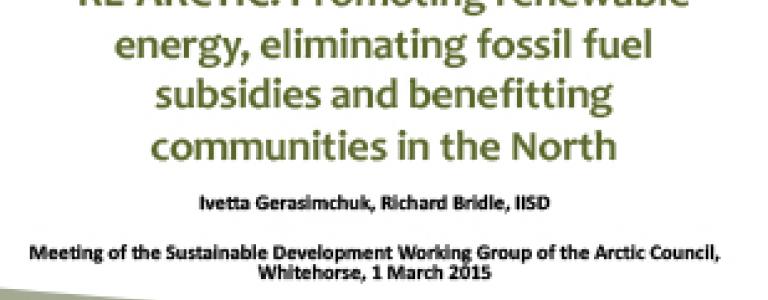RE-ARCTIC: Promoting renewable energy, eliminating fossil fuel subsidies and benefitting communities in the North
The International Institute for Sustainable Development (IISD) presented its vision of renewable energy development to the Sustainable Development Working Group of the Arctic Council in Whitehorse on March 1, 2015.
Renewable sources seem to be a straightforward way to provide “sustainable energy for all” in the Arctic. The Arctic has vast reserves of renewable energy, including hydro-, bio-, wind and geothermal power. Renewable energy technologies have been successfully tested and put in operation in the Arctic. Large-scale hydropower accounts for up to 75 per cent of electricity in Greenland and a significant share of electricity supply in northern Norway, Russia, Iceland and some other parts of the Arctic.
Small-scale renewable energy technologies and off-grid solutions for remote communities have also been successfully applied in the Arctic. There are striking similarities and synergies in terms of renewable energy solutions for small remote communities in the Arctic and in small island and archipelago states, in some of which (for instance, the Philippines or Cape Verde) renewable energy accounts for 25 to 30 per cent of electricity generation, with successful off-grid installations.
Yet, despite this evidence in favour of renewable energy development in the Arctic, the uptake of renewable energy in the region has been slow. The work that IISD has undertaken on successful policies for deployment of renewables around the world suggests several lessons learned that may be highly relevant for the Arctic:
Clear long-term targets and policies supporting renewables are essential to ensure investors’ decisions.
Phase-out of subsidies to fossil fuels (such as highly subsidized diesel in the Arctic), is essential to promote renewable energy. Subsidies to fossil fuels distort the playing field for renewable energy that can be cost-competitive in remote communities if there are no such distortions.
Public–private partnerships are essential; dedicated funds to support renewable energy development can be accumulated in a number of ways, including through environmental taxes (carbon tax, taxes on pollution, etc.).
Market integration on both the supply and demand sides is important to bring down the costs of renewable energy, which requires cooperation and synergies across different jurisdictions in the Arctic.
You might also be interested in
G20 Finance Ministerials and World Bank/IMF Spring Meetings: Expert comment
G20 finance ministerials and World Bank/IMF spring meetings will take place this week in Washington. High on the agenda is the need to mobilize trillions of dollars of investment in the transition to clean energy.
IISD Applauds Canada’s Reaffirmation to End Domestic Public Finance for Fossil Fuels in Budget 2024
Today's federal budget announcement delivers new measures to support affordability and reaffirms Canada’s commitments on climate action.
South Africa Fossil Fuel Subsidies Top $6 Billion, Study Shows
South Africa's fossil fuel subsidies rose to a 118 billion rand ($6.3 billion) in the 2023 fiscal year, providing incentives that encourage their continued use, according to a Canadian think tank. Government support for oil and gas consumption, electricity that's largely generated from coal, and carbon tax exemptions has tripled since 2018 in Africa's most industrialized nation, researchers at the Winnipeg-based International Institute for Sustainable Development wrote in a report published Tuesday.
South African Fossil Fuel Subsidies Hit Record Highs as Country's Energy Crisis Deepens
South Africa's fossil fuel subsidies tripled between 2018 and 2023, hitting USD 7.5 billion, up from USD 2.9 billion 5 years earlier, a new report by IISD reveals.
